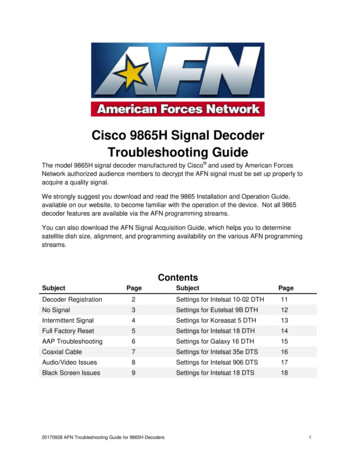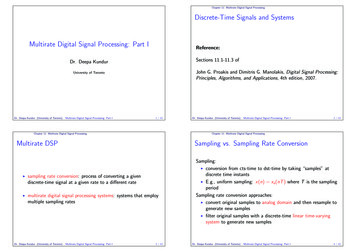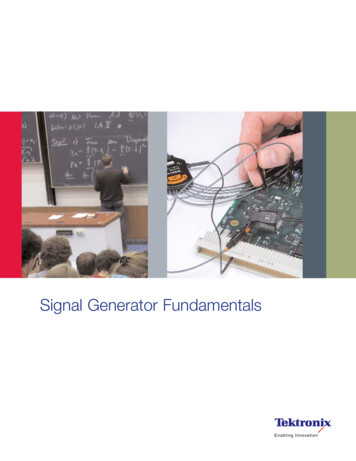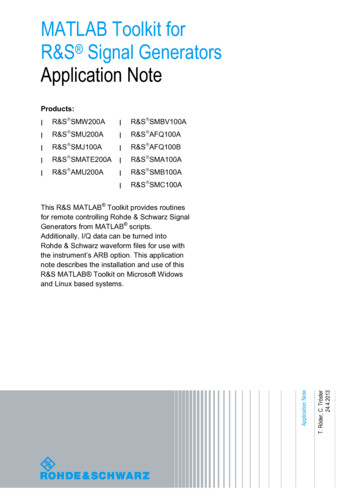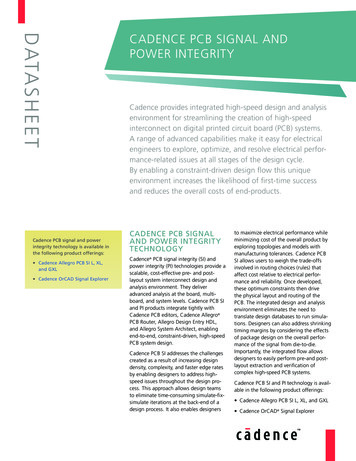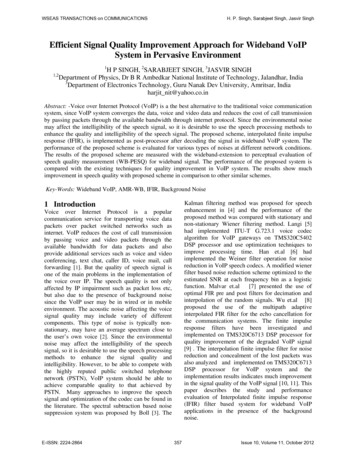
Transcription
WSEAS TRANSACTIONS on COMMUNICATIONSH. P. Singh, Sarabjeet Singh, Jasvir SinghEfficient Signal Quality Improvement Approach for Wideband VoIPSystem in Pervasive Environment11,2H P SINGH, 2SARABJEET SINGH, 3JASVIR SINGHDepartment of Physics, Dr B R Ambedkar National Institute of Technology, Jalandhar, India3Department of Electronics Technology, Guru Nanak Dev University, Amritsar, Indiaharjit nit@yahoo.co.inAbstract: -Voice over Internet Protocol (VoIP) is a the best alternative to the traditional voice communicationsystem, since VoIP system converges the data, voice and video data and reduces the cost of call transmissionby passing packets through the available bandwidth through internet protocol. Since the environmental noisemay affect the intelligibility of the speech signal, so it is desirable to use the speech processing methods toenhance the quality and intelligibility of the speech signal. The proposed scheme, interpolated finite impulseresponse (IFIR), is implemented as post-processor after decoding the signal in wideband VoIP system. Theperformance of the proposed scheme is evaluated for various types of noises at different network conditions.The results of the proposed scheme are measured with the wideband-extension to perceptual evaluation ofspeech quality measurement (WB-PESQ) for wideband signal. The performance of the proposed system iscompared with the existing techniques for quality improvement in VoIP system. The results show muchimprovement in speech quality with proposed scheme in comparison to other similar schemes.Key-Words: Wideband VoIP, AMR-WB, IFIR, Background NoiseKalman filtering method was proposed for speechenhancement in [4] and the performance of theproposed method was compared with stationary andnon-stationary Wiener filtering method. Langi [5]had implemented ITU-T G.723.1 voice codecalgorithm for VoIP gateways on TMS320C5402DSP processor and use optimization techniques toimprove processing time. Han et.al [6] hadimplemented the Weiner filter operation for noisereduction in VoIP speech codecs. A modified wienerfilter based noise reduction scheme optimized to theestimated SNR at each frequency bin as a logisticfunction. Malvar et.al[7] presented the use ofoptimal FIR pre and post filters for decimation andinterpolation of the random signals. Wu et.al [8]proposed the use of the multipath adaptiveinterpolated FIR filter for the echo cancellation forthe communication systems. The finite impulseresponse filters have been investigated andimplemented on TMS320C6713 DSP processor forquality improvement of the degraded VoIP signal[9] . The interpolation finite impulse filter for noisereduction and concealment of the lost packets wasalso analyzed and implemented on TMS320C6713DSP processor for VoIP system and theimplementation results indicates much improvementin the signal quality of the VoIP signal [10, 11]. Thispaper describes the study and performanceevaluation of Interpolated finite impulse response(IFIR) filter based system for wideband VoIPapplications in the presence of the backgroundnoise.1 IntroductionVoice over Internet Protocol is a popularcommunication service for transporting voice datapackets over packet switched networks such asinternet. VoIP reduces the cost of call transmissionby passing voice and video packets through theavailable bandwidth for data packets and alsoprovide additional services such as voice and videoconferencing, text chat, caller ID, voice mail, callforwarding [1]. But the quality of speech signal isone of the main problems in the implementation ofthe voice over IP. The speech quality is not onlyaffected by IP impairment such as packet loss etc,but also due to the presence of background noisesince the VoIP user may be in wired or in mobileenvironment. The acoustic noise affecting the voicesignal quality may include variety of differentcomponents. This type of noise is typically nonstationary, may have an average spectrum close tothe user’s own voice [2]. Since the environmentalnoise may affect the intelligibility of the speechsignal, so it is desirable to use the speech processingmethods to enhance the signal quality andintelligibility. However, to be able to compete withthe highly reputed public switched telephonenetwork (PSTN), VoIP system should be able toachieve comparable quality to that achieved byPSTN. Many approaches to improve the speechsignal and optimization of the codec can be found inthe literature. The spectral subtraction based noisesuppression system was proposed by Boll [3]. TheE-ISSN: 2224-2864357Issue 10, Volume 11, October 2012
NoisySpeechSignalAMRWBPacketization(VariationIn PacketSize)H. P. Singh, Sarabjeet Singh, Jasvir SinghPacket Loss SimulatorWSEAS TRANSACTIONS on OutputFig.1 Conceptual diagram of Proposed SystemThe noisy speech signal is encoded with Adaptivemulti-rate wideband (AMR-WB) [12] codec and theefficiency of the proposed system is tested atvarying packet size & varying packet loss ratenetwork conditions. The results of the proposedsystem are then compared with the system whichinvolves interleaving technique.The brief description of the proposedSystem, filter design is presented in the next section.The packet loss modeling is described in Section IIIand the Section IV presents the design of the IFIRscheme. The performance analysis results of theproposed scheme are presented in Section V. Thelast section concludes the work and presents thefuture work.In case of the larger size, there is a distortion in thevoice quality level [16]. The compressed signal isthen packetized into VoIP packets to transfer it tothe IP network. To check the network efficiency, thepacket size is varied from one to six voice famesinto single packet.Step4: To introduce the IP network impaired intospeech signal, the Gilbert model [17]-[19] is usedin this work. The signal is degraded with differentpacket loss rates.Step5: The degraded VoIP signal is depacketizedand then decoded with AMR-WB decoder.Step6: The proposed IFIR scheme is implementedon the degraded VoIP signal to enhance the signalquality.Step7: The signal measurement is performed withWB-PESQ. After comparing the degraded signalwith the original, the WB-PESQ measurement givesthe subjective measurements.2 Proposed SystemTo conceal the lost packet and reduce the effect ofenvironmental noise, the IFIR based scheme isproposed. The IFIR filter is applied as postprocessor after the decoding in the proposed system.The performance of the proposed system isevaluated with Wideband extension- PerceptualEvaluation of Speech Quality (WB-PESQ)measurement defined by ITU-T recommendationP.862.2 [13] for wideband coders. The proposedsystem is presented in Fig. 1. The simulation forVoIP system is performed in noisy environmentwith different types of background noises. The basicsteps in derivation of the proposed system are:Step 1: The noisy speech signal is fed in to thesystem, which is degraded with various types ofbackground noises including babble, car and streetat SNR of 0, 5, 10, 15 dB. The about 500 noisy andclean speech samples at different SNRs for bothmale and female are taken from [14].Step2: The noisy speech signal is then encoded withAMR-WB speech encoder at different data rates,which is the compressed version of the input signal.Step3: To save the bandwidth and to reduce theheader overhead in VoIP system, the multiplespeech frames are transmitted in single packet [15].E-ISSN: 2224-2864WB-PESQ MOS1-q1-p10qpFig.2 Two-state Gilbert Model3 Packet Loss ModelingPacket loss is a major source of speech impairmentin voice over IP networks. Packet losses are notindependent on a frame-by-frame basis, but appearin bursts. Such a loss may be caused by discardingpackets in the IP networks (network loss) or bydropping packets at the gateway/terminal due to latearrival (late loss). Network loss is normally causedby congestion (router buffer overflow), routinginstability such as route changes, link failure, andlossy links such as telephone modems and wirelesslinks. Congestion is the most common cause of loss.358Issue 10, Volume 11, October 2012
WSEAS TRANSACTIONS on COMMUNICATIONSH. P. Singh, Sarabjeet Singh, Jasvir SinghThe packet loss behavior of IP networks can berepresented as a Markov process because several ofthe mechanisms that contribute to loss are transientin nature (e.g. network congestion, late arrival ofpackets at a gateway/terminal, buffer overflow ortransmission errors) [20]. Several models [21, 22]have been proposed for modeling network losscharacteristics. A discrete Markov chain with a setof M states S ( S 1 , S 2 , , S M ) characterizes thethe conditional loss probability. Let p 0 and p 1denote the probability of the network model to be instate 0 and 1. The probability for a packet to bedropped regardless whether the previous packet isdelivered or dropped i.e. the unconditional lossprobability is exactly the probability for the networkmodel to be in state 1 ( p 1 ) ,p0 course of the process with regard to the current state,which may change over time at predefined events,such as packet arrivals, based on transitionprobabilities. Each state is associated with differenterror or packet loss behavior. Let q t denote thecurrent state at event time t , t N 0 . Then theprobabilities a ij to change from state q t 1 i toq t j are given in the transition matrixq;p qp1 pp q(3)The transition matrix is given as 1 pP qp 1 q (4)The speech signal of the VoIP system is degraded atdifferent packet loss rates at 2%, 4%, 8% and 10%as shown in theTable I.ATable I Simulated Loss Rates a11 A a M1 a1M a M M (1)With coefficientsa ij P ( q t S j q t 1 S i ) , i M , j M ,N aWherej 1ij 1;Mj 1q20.00320.1540.0120.2580.0250.25100.100.854 Interpolated FIR Filter DesignM πj 1j 1The multirate filtering is a novel method to savenumber of arithmetic operations for FIR filterdesigns. The filter is implemented as a cascade ofthe two FIR sections, where one section generatesthe sparse set of impulse response values with everyL th sample being non-zero and other sectionperforms the interpolation. The interpolated tely (1 / L ) th of the multipliers requiredfor conventional equivalent FIR filter. Multiratefiltering is effective in narrowband and widebandapplications. Since the internal data rate in IFIRfilters is constant, so there is no problem of internalaliasing which is one of the major designconsiderations in multirate filtering [23]. The modelfilter H m ( z ) with impulse response h m ( n ) isconsidered [24, 25]. The ( L 1) zero-valuedsamples are inserted between the original samplesof h m ( n ) . The up-sampled sequence h m' ( n ) is:(2)The error or packet loss rates in each stateE ( e1 , , e M ) ; 0 e j 1 and the output of theprocess O ( t ) as a binary sequence O ( t ) 0,1indicating an error or loss at an event with O ( t ) 1 ,whereas O ( t ) 0 stands for error free events,respectively.Most research in VoIP network uses a Gilbert modelto represent packet loss characteristics [17]-[19]. In2-state Gilbert model as shown in Fig.2, there aretwo states (state 0 and state 1). The state 0 representsthat a packet being correctly received and state 1represents that a packet being lost. Let p be thetransition probability for the network model to drop apacket given that the previous packet is delivered i.e.the probability for network model to go from state 0to state 1. Let q is the probability for the networkmodel to drop a packet given that the previous packetis dropped, i.e. the probability for the network modelto stay in state 1. This probability is also known asE-ISSN: 2224-2864pa ij 0The steady states probabilities can be found as:π k π j a jk , k 1, , M ;PLR (%) h (n / L), n iL, i 0, 1, 2, hm' (n) motherwise 0,(5)The Z-transform of hm' (n) is:359Issue 10, Volume 11, October 2012
WSEAS TRANSACTIONS on COMMUNICATIONSH. P. Singh, Sarabjeet Singh, Jasvir SinghH m' ( z ) H m ( z L )frequencies. The G ( z ) filter must pass everythingbelow the f p a s s frequency:(6)The implementation of H ( z ) is obtained from theimplementation of H m ( z ) by replacing each delaywith L delays. The interpolated impulse response isangeneratedbycascadingH m ( z L ) withinterpolator G ( z ) . The block diagram of the IFIRfilter is presented in Fig.3. The overall frequencyresponse becomes:'mH i ( z ) H m ( z )G ( z )f pass ,in t f pass(10)The image filter G ( z ) must suppress the closestreplica of H m ( z L ) starts at (1 / L ) f s t o p .,therefore: 1 f sto p ,in t f stop L (11)LX (n)(7)(c)The process of the designing an IFIR filtersummarized as:a) Select the suitable expansion factor L.b) Design the model filter H m ( z )Y (m)G (z )Hm(zL )c) Up-sample the model filter H m ( z ) by L tocreate H ( z L )d) Design the image filter G ( z ) to removereplicas.Fig.3 Interpolated Finite ImpulseResponse Filter(a)Expansion Factor (L)The expansion factor L must be a positive integervalue of which must be equal or greater than 2 andless than maximum value of Lmax,2 L Lmax(8)(d)(9)where, ω S L is the stop band edge frequency of thelow pass IFIR filter. It is recommended to select L,somewhat smaller than L m a x to avoid the morecomplex structure of the image filter [24, 26]. As theexpansion factor increases, the order of the modelfilter decreases. Consequently, a higher order imagefilter is needed to remove replicas.(b)Image Filterand ω p and ωs are the passband and stopband edgefrequencies. The proposed IFIR scheme for VoIPspeech signal improvement is designed using theMATLAB. For wideband system, the cutofffrequency is 6900 and sampling frequency is16000Hz. The number of multipliers required are 148 withexpansion factor L 2, in comparison to theconventional FIR filter which require 262 number ofmultipliers and the computational complexity isreduced by 45% with IFIR filter in comparison tothe conventional filter. The passband and stopbandripples for the designed filter are 0.001 and 0.001resp. The Fig.4 and Fig.5 present the magnituderesponse and impulse response of the designed filterdesigned with conventional design technique andwith IFIR design technique. This computationallyefficient IFIR filter is suitable for the VoIPG (z)The purpose of the image filter G ( z ) from timedomain point of view is exactly that computing whatthe zero-valued samples of H m ( z L ) should be. Fromfrequency-domain point of view, interpolatorG ( z ) must attenuate the replicas of H m ( z L ) infrequency domain. From both points of view it isadvantageous to have the order of G ( z ) as small aspossible, in order to achieve the computationalefficiency of IFIR implementation [26]. To reducethe order of G ( z ) to the smallest possible, it isimportant to carefully consider band edgeE-ISSN: 2224-2864Computational Complexity:The computational complexity is computed in termsof the number of multipliers needed forimplementation of the digital filter [24, 25]. In IFIRfilter the passband and stopband widths are only(1/ L )th of those of the model filter. The effect of theinterpolation of the impulse response is to shrink thepassband and transition bands without anysignificant increase in the number of arithmeticoperations. The length of the required FIR filter forgiven specifications is approximately [27]:Where, δ1 and δ 2 are the passband and stop ripplesThe maximum possible expansion factor Lmax isdetermined using the following relationship:Lmax [π / ωSL ]Design Steps:360Issue 10, Volume 11, October 2012
WSEAS TRANSACTIONS on COMMUNICATIONSH. P. Singh, Sarabjeet Singh, Jasvir Singhapplications and it significantly reduce the noisecontent in the speech signal.(b)(a)Fig 5. Impulse responses (a) FIR filterH ( z ) (b) IFIR filter H i ( z )5 ResultsThe performance results of the proposed system areevaluated for varying packet loss rates and for VoIPpacket sizes in various noisy conditions as discussedhere below:(I) Variation of Packet size & Packet loss rateThe performance of the proposed IFIR based noisereduction system is evaluated for wideband VoIPsystem at varying packet sizes and varying packetloss rates. The packet size used in during thesimulation varied from one voice frame per packetto six voice frames per packet and the signal isdegraded with packet loss at various packet lossrates varying from 2% to 10%. The average gain inWB-PESQ MOS scores at each packet size fordifferent packet loss rates is plotted in Fig.6 andFig.7 for AMR-WB 15.85 kbps and AMR-WB18.25 kbps respectively. The proposed system iseffective not only for single voice frame in eachpacket transmission but also very much effective forthe multiple voice frames in each packet. Themultiple frame transmission leads to the saving ofbandwidth in the network which can be used forother purposes in the VoIP system. The significantincrement in MOS scores is achieved for higherpacket loss rate, as presented in Fig.6 and Fig.7.(b)Fig 4. Frequency responses (a) FIRfilter H ( z ) (b) IFIR filter H i ( z )(II) Evaluation for various noise typesThe performance of the proposed system isevaluated for various types of the noisy conditionsincluding babble, car and street noise at differentSNR 0, 5, 10 and 15 dB in wideband VoIP system.At various packet sizes, the gain in the WB-PESQ(a)E-ISSN: 2224-2864361Issue 10, Volume 11, October 2012
WSEAS TRANSACTIONS on COMMUNICATIONSH. P. Singh, Sarabjeet Singh, Jasvir SinghMOS scores for each noise type is plotted againstvarying packet loss rates in Fig. 8 and Fig. 9 forAMR-WB 15.85 kbps and AMR-WB 18.25 kbpsrespectively. In case of babble noise, AMR-WB at15.85 kbps gives better results at high SNR with alltested packet sizes. In case of car noise for smallpacket sizes gives good results at low SNR and forlarge packet size, the high SNR gives significantincrement in MOS scores. Low value of SNR isbetter in case of street noise with AMR-WB 15.85kbps as given in Fig.8. For AMR-WB 18.25 kbps,the increasing value of SNR is preferred withincreasing packet sizes with babble noise type. Themuch better results can be found at low SNR valuesat all tested packet sizes with car and street noises.The results of AMR-WB 18.25 kbps are presented inFig.9.(a) Babble Noise at Packet Size 20 ms(b) Babble Noise at Packet Size 120 msFig.6 Signal coded with AMR-WB 15.85 kbps(c) Car Noise at Packet Size 20 ms(d) Car Noise at Packet Size 120 msFig.7 Signal coded with AMR-WB 18.25 kbpsE-ISSN: 2224-2864362Issue 10, Volume 11, October 2012
WSEAS TRANSACTIONS on COMMUNICATIONSH. P. Singh, Sarabjeet Singh, Jasvir Singh(e) Street Noise at Packet Size 20 ms(c) Car Noise at Packet Size 20 ms(d) Care Noise at Packet Size 120 ms(f) Street Noise at Packet Size 120 msFig. 8 Effect of IFIR filter on VoIP speech signal withAMR-WB (15.85 kbps) codec for noise at different SNR(e) Street Noise at Packet Size 20 ms(a) Babble Noise at Packet Size 20 ms(f) Street noise at Packet Size 120 msFig.9 Effect of IFIR filter on VoIP speech signal withAMR-WB (18.25 kbps) codec for noise at different(b) Babble Noise at Packet Size 120 msE-ISSN: 2224-2864363Issue 10, Volume 11, October 2012
WSEAS TRANSACTIONS on COMMUNICATIONSH. P. Singh, Sarabjeet Singh, Jasvir Singh(III) Comparison with interleaving methodInterleaving technique is widely used packet lossconcealment technique when the multiple frames areused in single VoIP for concealment of the lostpackets during VoIP communications. Thewideband coder AMR-WB is also capable forsupporting the interleaving as packet lossconcealment technique during the networkcommunications[28]. To reduce the effect ofpacket loss on perceived speech quality, the lostpackets have to be regenerated at the receiver usingpacket loss concealment algorithms. Goodman et.al[29] had used Waveform substitution algorithmssuccessfully for pulse code modulation (PCM)speech coder.The lost packets were alsoregenerated with the use of time scale modificationalgorithms [30, 31]. The lost packets during networkare also estimated with interleaving technique [32,33]. The interleaving process over four consecutiveframes is depicted in Fig.10.(a) Packet Size 20 msFig. 10 Interleaving packet loss concealment scheme (a)Original four frames (b) Four frames interleaved (c)Frame loss (d) Reconstructed frames(a)(b) Packet Size 120 msFig.11 Comparison results for noise at different SNR forfiltered and interleaved VoIP speech signal coded withAMR-WB (15.85 kbps) codecComparison at various SNR and PLRThe average gain in WB-PESQ MOS scores is takenfor various noise types at different packet loss ratesfor both filtered and interleaved output. Thecomparison results for wideband VoIP systems arepresented in Table II- Table III. The significantimprovement can be noticed in the results obtainedwith IFIR scheme in VoIP system at variousnetwork conditions. The proposed system givesmuch better results for small packet sizes and alsooutperforms the existing interleaving technique forpacket loss concealment at large packet size.E-ISSN: 2224-2864(b)Comparison for various noise types:The comparison results at various packet sizes withvarying packet loss rates for different noise types ispresented in Fig.11-Fig.12. The average gain inWB-PESQ MOS scores is taken for various SNR atdifferent packet loss rates for both filtered andinterleaved output. For wideband VoIP systems, theproposed IFIR filter results outperform theinterleaved results for each type of noise used in thepresent work.364Issue 10, Volume 11, October 2012
WSEAS TRANSACTIONS on COMMUNICATIONSH. P. Singh, Sarabjeet Singh, Jasvir Singhoutperforms the existing packet loss concealmenttechnique such as interleaving, when comparedduring VoIP simulations in noisy conditions. Theaverage PESQ-MOS gains of 0.57 and 0.59 isachieved with AMR-WB 15.85 kbps and AMR-WB18.25 kbps respectively by the proposed method forsix voice frames in each VoIP packet in all noisyconditions. It is found that our proposed systemoffer much improvement as compared to the resultsof interleaving method where the average increase inPESQ-MOS scores were 0.33 and 0.30 for singlepacket and six packets in each frame respectively forAMR-WB 15.85 kbps mode. The average gain inPESQ-MOS for AMR-WB 18.25 kbps is 0.38 and0.32 for single and six voice frames in each packetrespectively. The proposed filter not only reducesthe background noise but also conceals the lostpackets due to network impairments to improve thespeech quality of the VoIP signal. Thus ourproposed IFIR scheme can be efficiently used forVoIP applications. In future, the study can beconducted in real time with digital signal processorssuch as TMS320C6713.(a) Packet Size 20 msReferences:[1] J W Goralski and C M Kolon, IP Telephony, 1st ed.:McGraw-Hill, 2000[2] Jacob Benesty, M M Sondhi, and Yiteng Huang,Handbook of Speech Processing: Springer, 2008[3] S F Boll, "Suppression of acustic noise in speechusing spectral subtraction," IEEE Transactions onAcousttics, Speech and Signal processng, vol. 27, no. 2,pp. 113-120, 1979.[4] A.Basu K.K.Paliwal, "A speech enhancement methodbased on Kalman filtering," in Proceedings of IEEEInternational Conference on Acoustics, Speech and SignalProcessing, 1987, pp. 177-180.[5] A Z R Langi, "A DSP implementation of a voicetranscoder for VoIP gateways," in Proceedings of AsiaPacific conference on circuits & systems, APCC’02, vol.1, 2002, pp. 181-186.[6] S Han, S J HYang, and J Kim, "Noise reduction forVoIP speech codecs using modified Wiener Filter," innovations in Systems, Computing Sciences and SoftwareEngneering, K.Elleithy, Ed.: Springer, 2007, pp. 393-397[7] H S Malvar and D H Staelin, "Optimal FIR pre- andpostfilters for decimation and interpolation of randomsignals," IEEE Transactions on Communication, vol. 36,no. 1, pp. 67-74, 1988.[8] C S Wu and A Y Wu, "A novel cost effective multipath adaptive interpolated FIR (IFIR)- based echocanceller," in Proceddings of IEEE InternationalSymposium on Circuits and Systems, vol. 5, 2002, pp. V453-V-456.[9] H P Singh, S Singh, and J Singh, "Processing of VoIPSignal using TMS320C6713 in digital domain," inProceedings of IEEE Second International Conference on(b) Packet Size 120 msFig 12 Comparison results for noise at different SNR for filteredand interleaved VoIP speech signal coded with AMR-WB(18.25 kbps) codec6 ConclusionThe work in this paper proposes the use ofinterpolated finite impulse response (IFIR) filter fornoise reduction and packet loss concealment duringnetwork simulations. The proposed IFIR filter isapplied in the post-processing, i.e. after the decodingof signal. The results show that the proposed IFIRfilter is very much effective in all types of noise atdifferent SNR. The performance evaluation studyshows that the proposed system gives much betterresults in VoIP impairments including packet loss inaddition to the background noise. The simulationresults for VoIP system in noisy environment withAMR-WB 15.85 kbps and AMR-WB 18.25 kbps,shows the average increase of 0.67 and 0.68 resp. inPESQ-MOS scores for packet size of one voiceframe in each packet. For multiple voice frames ineach packet for VoIP system, the proposed systemE-ISSN: 2224-2864365Issue 10, Volume 11, October 2012
WSEAS TRANSACTIONS on COMMUNICATIONSH. P. Singh, Sarabjeet Singh, Jasvir Singh[22] W Jiang and H Schulzrinne, "QoS Measurement ofInternet Real-Time Multimedia Services," ColumbiaUniversity, Technical Report CUCS-015-99, Dec. 1999.[23] S K Mitra, Digital Signal Processing: A ComputerBased Approach, with DSP Laboratory using MATLAB,2nd ed.: Mc.Graw Hill, 2001.[24] Y Neuvo, C Y Dong, and S K Mitra, "Interpolatedfinite impulse response filters," IEEE Transactions onAcoustics, Speech and Signal Processing, vol. 32, no. 3,pp. 563-570, 1984.[25] T Saramaki, Y Neuvo, and S K Mitra, "Design ofcompuationally efficient interpolated FIR filters," IEEETransactions on Circuits and Systems, vol. 35, no. 1, pp.70-88, 1988.[26] A Ivanov, "Case study of recent improvements ininterpolated finite impulse response (IFIR) filter c/download;jsessionid CAF4EDC0ED5084E79DCEC1B26E3FF50C?doi 10.1.1.84.550&rep rep1&type pdf, EEN 436, Section C,2007[27] J D Proakis and D G Manolakis, Digital SignalProcessing: Principles, algorithm and applications, Thirdedition ed.: Prentice Hall, June2000.[28] J Sjoberg, M Westerlund, A Lakaniemi, and Q Xie,"Real-Time Transport Protocol (RTP) Payload Formatand File Storage Format for the Adaptive Multi-Rate(AMR) and Adaptive Multi-Rate Wideband (AMR-WB)Audio Codecs," RFC 3267, 2002[29] D Goodman, G Lockhart, O Wasem, and WaiChoong, "Waveform substitution techniques forrecovering missing speech segments in packet voicecommunications," IEEE Transactions on Acoustics,Speech and Signal Processing, vol. 34, no. 6, pp. 1440 –1448, 1986[30] M.Roelands W.Verhelst, "An overlap-add techniquebased on waveform similarity (WSOLA) for high qualitytime-scale modification of speech," in Proceedings ofIEEE International Conference on Acoustics, Speech andSignal Processing, ICASSP, vol. 2, 1993, pp. 554-557[31] A.Stenger, K.B.Younes, B.Girod H.Sanneck, "A newtechnique for audio packet loss concealment," inProceedings of IEEE Global TelecommunicationConference, 'Communications: The Key to GlobalProsperity, 1996, pp. 48-52[32] J L Ramsey, "Realization of optimum interleavers,"IEEE Transactions on Information Theory, vol. 16, no. 3,pp. 338-345, May 1970[33] F Merazka, "Improved packet loss recovery usinginterleaving for CELP-type speech coders in packetnetworks," IAENG International Journal of ComputerScience, vol. 36, no. 3, Feb 2009.Computer Engineering and Applications, vol. 1, 2010, pp.606-610[10] H P Singh, S Singh, R K Sarin, and J Singh,"Analysis of FIR interpolation filter for VoIP in noisyenviroment," in Proceeding of IEEE 2nd ,Communication Systems and Networks, 2010, pp. 268273.[11] J Singh, H P Singh, and S Singh, "Implementation ofFIR Interpolation Filter on TMS320C6713 for VoIP," inProceedings of IEEE Second International Conference onComputational Intelligence, Communication Systems andNetworks, 2010, pp. 289-294.[12] 3GPP.TS 26.190, "Speech codec speech processingfunctions; Adaptive Multi-Rate -Wideband (AMR-WB)speech codec; Transcoding functions," 2009.[13] ITU-T Recommendation. P.862.2, "WidebandExtension to Recommendation P.862 for the assessmentof wideband telephone networks and speech codecs,"2005.[14] http://www.utdallas.edu/ loizou/speech/noizeus/[15] M Baldi and F Risso, "Efficiency of packet voicewith deterministic delay," IEEE CommunicationsMagazine, vol. 38, no. 5, pp. 170-177, 2000.[16] M Hassan and D F Alekseevich, "Variable packetsize of IP packets for VoIP transmission ," in Proceedingsof the 24th IASTED International Multi-Conference onInternet and Multimedia Systems and Applications, 2006,pp. 136-141.[17] S Jelassi, H Youssef, C Hoene, and G Pujolle,"Voicing aware parametric speech quality models overVoIP networks," in Proceedings of the Secondinternational conference on Global InformationInfrastructure Symposium, Hammamet, Tunisia, 2009,pp. 120-127.[18] C C Wu, K T Chen, C Y Huang, and C L Lei, "AnEmpirical evaluation of VoIP playout bufferdimensioning in Skype, Google Talk and MSNmessenger," in Proceeding of 19th InternationalWorkshop on Network and Operating System Support forDigital Audio and Video 2009, pp. 97-102.[19] O Hohlfeld, G Rudiger, and G Halblinger, "Packetloss in real-time services: Markovian Models generatingQoE impairments," in Proceedings of IEEE 16thInternational workshop on quality of service, (IWQoS),2008, pp. 239-248.[20] M S Borella, "Measurement and Interpretation ofInternet Packet Loss," Journal of Communication andNetworking, vol. 2, pp. 93–102, June 2000.[21] M Yajnik, S Moon, J Kurose, and D Towsley,
improvement in speech quality with proposed scheme in comparison to other similar schemes. Key-Words: Wideband VoIP, AMR-WB, IFIR, Background Noise 1 Introduction Voice over Internet Protocol is a popular communication service for transporting voice data packets over packet switched networks such as internet.



